The Quest For The Worst Adventure Game Puzzles - The Journeyman Project 2: Buried in Time (Part 1)
By ZombiePie 3 Comments
Author's Note: Here are links to previous episodes of this series:
- Episode 1: The Dig
- Episode 2: Atlantis: The Lost Tales
- Episode 3: Loom
- Episode 4: Drowned God
- Episode 5a: Indiana Jones and the Fate of Atlantis Part 1 & Episode 5b: Indiana Jones and the Fate of Atlantis - Part 2
- Episode 6: The Journeyman Project: Pegasus Prime
Preamble
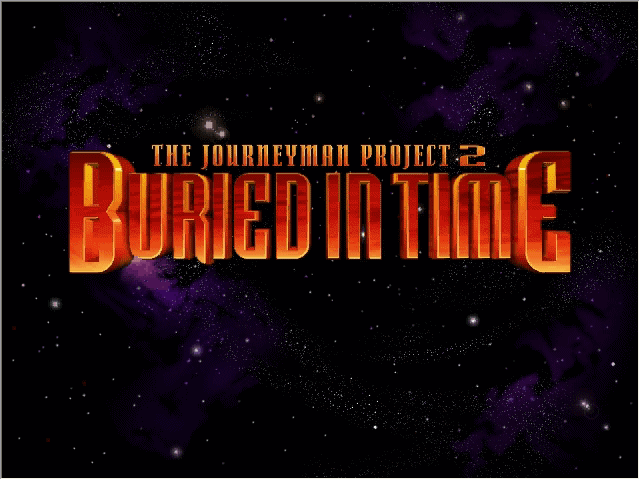
It has been over a month since I last published one of these adventure game blogs, but old habits die hard. With this episode, I will be returning to the FMV world of The Journeyman Project, but this time my deep analysis will target the second game in the series. I ended my post on The Journeyman Project: Pegasus Prime with a proclamation that it was one of the better introductory games to the late-90s FMV era of PC adventure games. I stand by that because The Journeyman Project 2: Buried in Time is a definite jump in difficulty and features more of the expected "hiccups" of an FMV game. Don't get me wrong; Buried in Time is a game I had a blast playing. Nonetheless, it is undoubtedly the least welcoming entry in the franchise for newcomers or those whose only impressions of the adventure game genre are LucasArts, Ron Gilbert, or Tim Schaffer. I have played these games for almost all my life, and this game still managed to kick my ass, but more on that later.
And yet, I still love this game. As mentioned in the previous episode, you can never claim that Presto Studios, the team behind The Journeyman Project series, wasn't trying their best whenever they made one of these games. With Buried in Time, you get the sense they had a far larger budget to work with and had bigger storytelling aspirations. With The Journeyman Project 1 or Pegasus Prime, you got a story that was a total mess that eventually went to some wild and insane places. Buried in Time doesn't wait to kick into high gear. After starting a new playthrough, you first see an incredibly over-the-top FMV cutscene where a man in a ridiculous spacesuit claims to be you from the future and that your life is in danger. Then, in one of your first "official" levels, you explore a derelict space station before acquiring a sentient artificial intelligence that enjoys cracking turn-of-the-century puns and one-liners! Buried in Time oozes with 90s charm, and if you have any nostalgia for this era of games, that will keep you going while you butt up against some of its bizarre design choices.
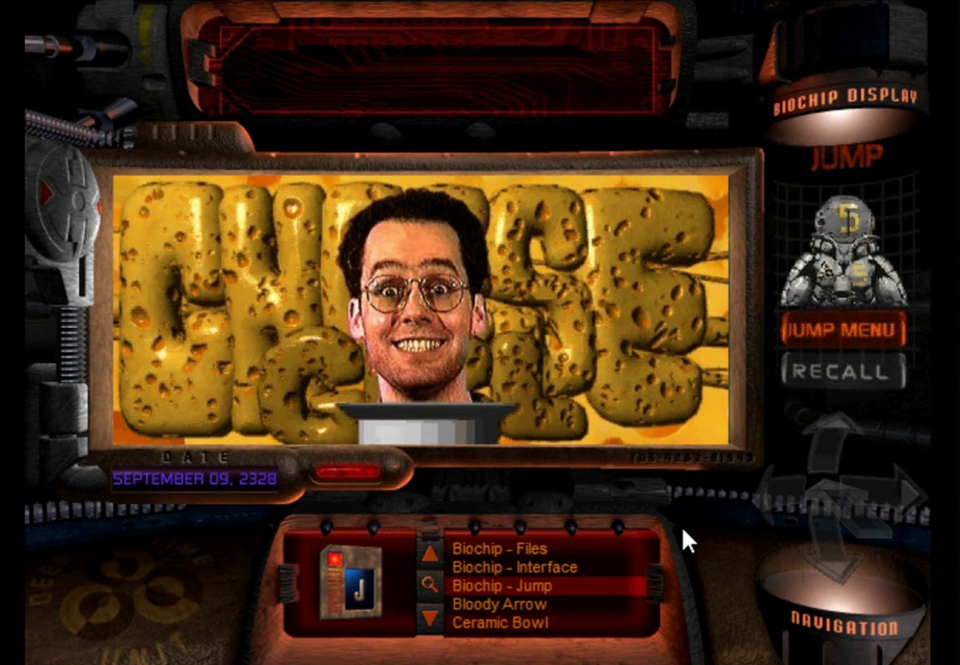
Speaking of which, there are some consequences to Buried in Time utilizing the format and structure of its predecessor but applying it to a grander stage. Much like the first game, you'll need to hop back and forth across various environments and timelines to address roadblocks in subsequent levels. Including the introductory hub world, there are seven levels in Buried in Time, and each features up to twenty or so fully explorable screens that can have trinkets or puzzles where you least expect them. Much like the early Myst games, your playable character can examine any screen you are in using fully rendered 3D movement on an x and y-axis. This design presents plenty of frustrations as you'll often need to find a specific location or screen in the game and then turn down to look at the floor and click a random pixel to put an item in your inventory. However, I predict the game's backtracking will represent most players' prominent source of frustration. If you elect not to have a guide on standby, you'll often find yourself staring at historical monuments or gizmos with no input from the game that the missing piece to what you are stuck on is five to six levels deep in a different setting. Again, if you are asking me what any of this translates to in terms of a recommendation, I would start with Pegasus Prime and see if that game's old-school design is too much before jumping headfirst into the far more ambitious Buried in Time.
Finally, for various reasons, I will be breaking this examination on Buried in Time into two parts. While a quick review of HowLongToBeat might suggest the game is a scant seven to eight hours, that's pretty long for a game of this type. I finished Pegasus Prime and even the third game well under that amount. When you start playing Buried in Time, you'll immediately discover why it's considered the most extensive and challenging entry in the series. The environments and levels in this game dwarf the ones in the first game, and unlike the series' third entry, Buried in Time feels like a full-featured folly. The environments you explore are dense, and their puzzles are far more complex. So, to spare everyone from reading a manifesto on FMV adventure game design, I decided to make things easier. Simply going from the start of the game to its halfway point, I managed to crest at the word total of my write-up on the entirety of Pegasus Prime.
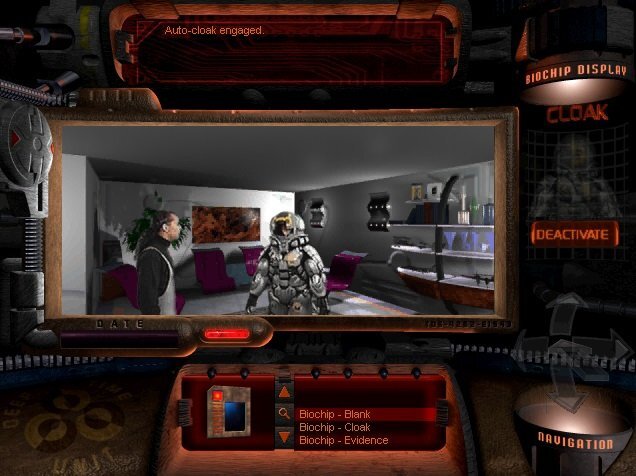
Ratings Explained: I'm using a continuum ranging from 1 to 10. Puzzles ranging from one to four are accessible sequences or set pieces that can be solved without guides or hints, regardless of your puzzle game expertise. Puzzles ranked between five and six are ones that only intermediate puzzle game players can solve, but beginners can solve in-game through clues, hints, or significant trial-and-error. From seven and above, we get into puzzles that most players cannot solve without consulting outside resources. Also in this category are puzzles that have major accessibility issues.
Gage Blackwood's House (Part 1)
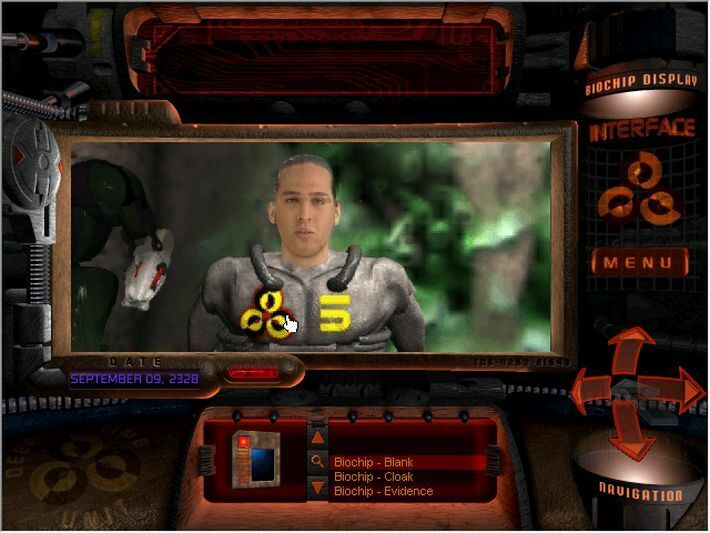
Finding The Gage Blackwood Action Figure - 2/10 - During the game's introductory cutscene, a version of your character from the future warns you about a grand conspiracy. You discover that your character is under house arrest in the present timeline for committing "crimes against the space-time continuum." Before your futuristic doppelganger departs, he relays that he hid a special message on how to prove your innocence and "reveal the truth" about what's happening in the world of The Journeyman Project 2. What that happens to be is an action figure stacked on top of your bookcase that, when clicked, plays a Mission Impossible-styled story summary. It's a bit on the contrived side, and the learning curve on how to control the game isn't the best, but it is a decent enough tutorial puzzle. Along your way, you interact with other pieces of furniture that either exist as pure window dressing or fill in some gaps in the game's worldbuilding. Overall, it's a manageable pixel hunt.
Using The Enviro-Projector Room To Collect Shopnet Order Numbers - 4/10 - Here's where Buried in Time's design may make or break for most people. The message I mentioned earlier warns Gage Blackwood to explore their apartment to "collect all of the resources necessary to prove your innocence." That one line is your only clue that there are two inventory items in the apartment which, if not collected, will result in you being unable to progress the story. These items are a can of aerosol cheese called a "Cheese Girl" and a translation BioChip. Where Buried in Time complicates things is how you unlock the ability to possess these items. You first need to enter your living room, which is siloed away from the kitchen, and then use your home entertainment system. While watching the news, you must record these items' shipping/order numbers while observing their advertisements. The lack of signposting makes this a jump-up in difficulty from the previous puzzle. Worse, one of the advertisements is for a music album that has nothing to do with progressing the story. It also does not help that the order numbers for these products are incredibly long. Correspondingly, if you fail to write the codes down quickly, the game transitions to the news, thus causing you to restart the whole process. If you enjoy some FMV-based goodness, this isn't that bad of a time. It's not an impossible task once you understand what you need to locate, but an annoying one nonetheless.
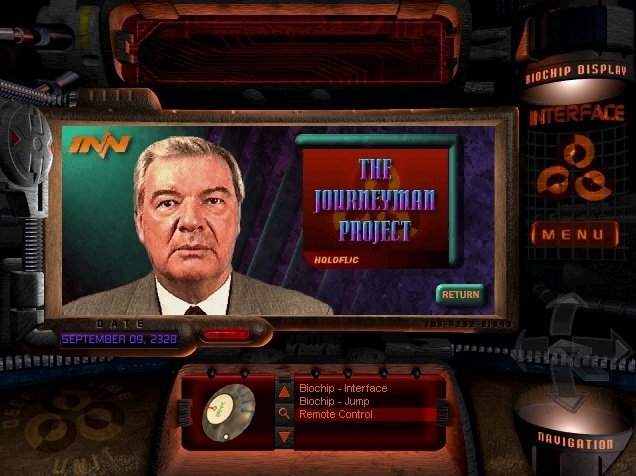
Using The Replicator To Order The Cheese Girl And Translate BioChip - 2/10 - The good news about collecting those order forms is that the next part of the process, ordering the goddamn things, isn't that hard. All you need to do is find the food replicator in your kitchen, which is impossible to miss and select the "ShopNet" mode, where you can search for and order the necessary items. The one added step that caught me off guard is that you also need to select the "Replicate" button to create the items and add them to your inventory. I thought the process of ordering them added them to your inventory automatically when I first played the game. Also, in the case of the Cheese Girl, you need to reorder one-time-use items if you misuse them, which can involve a lot of backtracking thanks to the game's trail-and-error adventure game design. More on that in a minute.
Farnstein Lab (Part 1)
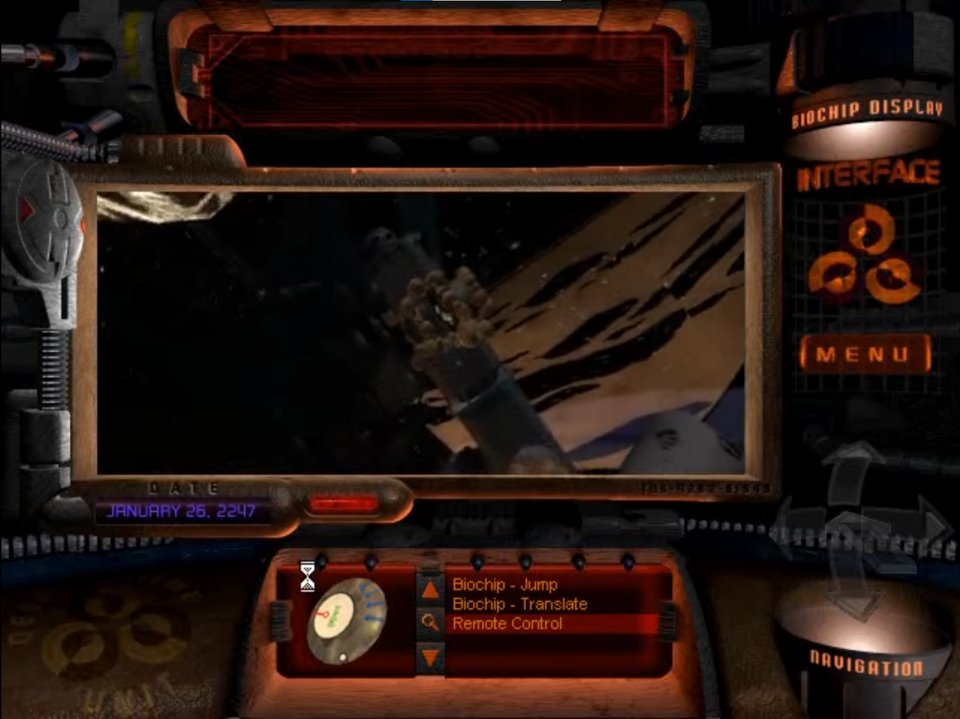
Using The Cheese Girl To Navigate The Vacuum Of Space - 2/10 - Similar to the first game, once you get into the timeline jumping part of Buried in Time, it presents four possible locations you can jump to at any time. The lucky news with Buried in Time is that, IN GENERAL, no energy meter ticks away after you warp to a location. The lone exception to that is the Farnstein Lab which, because it exists in space, features a time limit (i.e., a rapidly dwindling oxygen meter) that does not exist in other environments. To make matters worse, even upon entering the space station, you discover the entire facility has been depressurized. This time limit continues until you find a way to pressurize a room you are in, but the station can only do that once. If you accidentally select the wrong room, you must warp back to the apartment, reorder a Cheese Girl, and try again from scratch.
As a result, Farnstein Lab is my least favorite level in Buried in Time by a country mile. Things are not off to a great first impression when, after warping to the station, you discover the coordinates to the entrance are wrong, cannot correct them, and need to use the Cheese Girl to propel yourself to the space station. After doing this once, it becomes an automatic reaction upon warping there. However, your first experience involves fumbling through the inventory system and seeing which items allow you to move forward. Also, where you use the can of cheese determines the direction you move. If you use the can of cheese, a one-time-use item, in the wrong place, you need to warp back to the apartment, reorder it, and try again. As I said with the previous two puzzles, it is not necessarily hard, but it's fiddly, and the time limit makes it more nerve-racking than it needs to be.
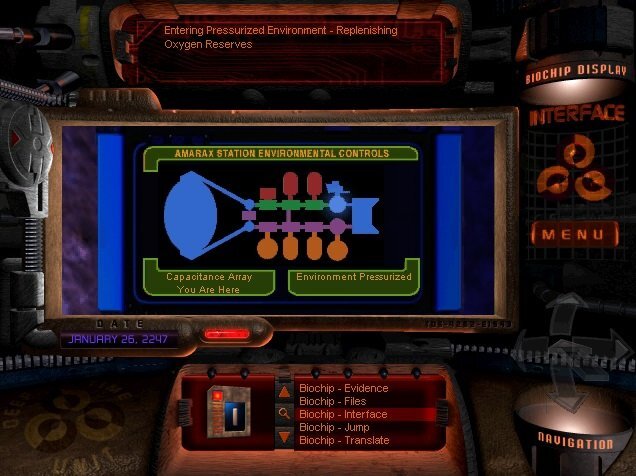
Pressurizing The Capacitance Array - 4/10 - After using the can of cheese to propel Gage to the entrance of the space station, you need to open an airlock and continue moving forward into a large room until a sentient artificial intelligence starts yelling. What I find especially heinous is how some of these screeds are required unskippable cutscenes that eat into your time limit. While in the main room, you need to take note of a sign that says "Capacitance Array." When using a computer terminal, select that room when given the option to pressurize one room of your choice. There's also a metal bar you can pick up blocking a door you will need to use later. As I warned earlier, there are dozens of rooms to choose from on the terminal, some you cannot even enter, and if you misclick, you will need to restart from the beginning. Moreover, the computer terminal is easy to miss as it blends with the environment's grey and black palette. With a time limit running in the background, finding it is undoubtedly stressful. Luckily for all involved, after pressurizing the room, you no longer need to worry about the time limit as it has a steady flow of oxygen. This puzzle is a little on the hunt-and-peck side, but it is acceptable in my book.
Exiting The Docking Bay - 5/10 - The artificial intelligence from earlier introduces himself as "Arthur" and states he is willing to help you if you assist him in leaving the space station. The first step towards completing this involves exiting the main room and exploring the station's docking bay. Unfortunately, a force field-based conveyor belt system prevents you from entering or exiting the room quickly. Here, you take note of the directions the force field throws you and find the correct directional inputs to get to the other side. There are a few ways for you to select the wrong directions and end up right back at the entrance. Also, the game's first-person perspective makes it even harder to get your bearings straight, and the lack of visual variety makes it impossible to tell if you are making progress. This puzzle reminded me of the ice skating levels in Chip's Challenge but on crack. It's still a puzzle you can brute force if you get lucky, but it can become an incredibly frustrating task if you are not in a position to take notes.
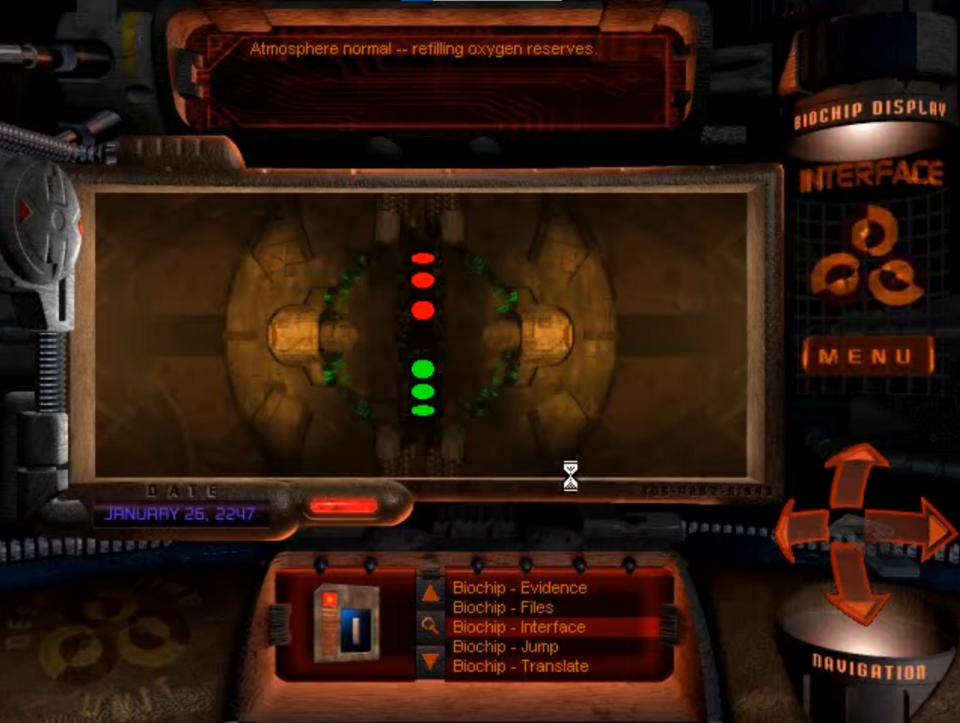
Opening The Lock To Arthur - 3/10 - When you make your way to the docking bay door, Arthur greets you and asks again if you are willing to help him leave the station. Once you agree, he directs you to a room called "The Nexus." When you first open the door to this room, Arthur provides the answer to the numerical lock that stands in your way (i.e., 32770). After prying away a few layers, the inner part of the Nexus displays three red lights on the top and three green lights on the bottom. You move the dots so they leap over one another (ala checkers) until the green and red dots have swapped places. It's a simple logic puzzle, and if you end up in a fail state, the puzzle resets itself. Just be careful as you have entered a new room that is not pressurized, and the time limit from before is back, but luckily reset to its starting level. This callback might be a reach, but this puzzle is reminiscent of the Leap of the Locust puzzle in Jewels of the Oracle. If that reference means anything to even one person on the internet, please let out a yelp.
The Mayan Temple & Caves (Part 1)
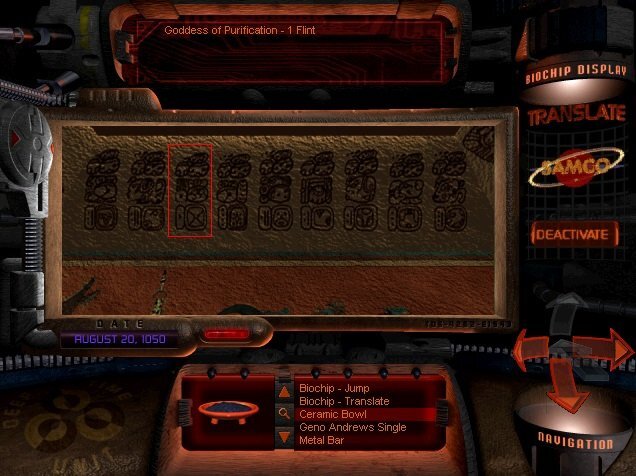
Using The Translate BioChip On The Maya Script At The Temple - 2/10 - As is the case with every single Journeyman Project game, your first time exploring the Mayan temple is brief. In the Journeyman Project games, there is always at least one level wherein your first rodeo is to warp into the level, fiddle with one thing, pick a random item up, and leave. The first step here is one of the more enjoyable storytelling moments in the game. Using the Translate BioChip and Arthur, you can learn about the ancient Maya and their religious practices as if you are using Microsoft Encarta. The trick is to use the translation tool on the four edges of the temple and take note of the gods and sacred animals mentioned in the script.
I forgot to mention this earlier, but Buried in Time improves upon the first game by boiling down your necessary BioChips to just a half dozen. This improvement makes exploring environments and interacting with items more enjoyable and accessible. The real issue here, and from this point forward, is how you feel about Arthur and his wisecracks. If ever there was a part of the game that dates it more than its use of FMV, it has to be the turn of the century pop culture references he interjects into the story if you choose to interact with him. The key word is "choose." You can elect not to use him beyond the story sequences that require him.
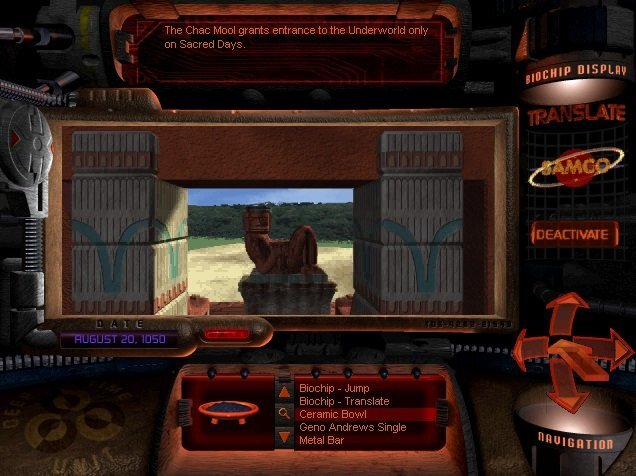
Using The Maya Combination Lock To Drop To The Caves - 5/10 - Getting to the bottom of the temple is something you will likely do several times in a single playthrough. Much like ordering the Cheese Girl, it becomes an automatic process with practice, but figuring things out the first time is a chore. Inside the temple is a Maya version of a combination lock. On one side of the wheel are symbols of animals, and on the other are dots and lines resembling the Maya counting system. The trick is to remember the scripts from earlier and recall which numbers match with the correct animals. You do not need to use the machine more than once; all you need to do is set one animal symbol to the correct number. With this out of the way, you need to find a bowl of water and place the bowl in the hands of a statue at the temple's entrance. This action will trigger a trap door that will lead to the underground cave system or immediate death. Because this puzzle involves a decent amount of lore and mythos building, I did not mind it though it is worth mentioning that leaving the temple complex results in a "Game Over."
Picking Up The Copper Medallion - 2/10 - Remember when I briefly mentioned how some of the puzzles in this game utilize 3D movement and require the player to look up or down to pick up random items? This sequence is one such example of that. After dropping down into the cave system, your only task is locating a skeleton and snatching the copper medallion in its clutches. You are free to explore the caves, but the doors remain locked until you collect more items from the other supporting levels. It's a shitty move, but par for the course regarding adventure games of this specific era.
Château Gaillard
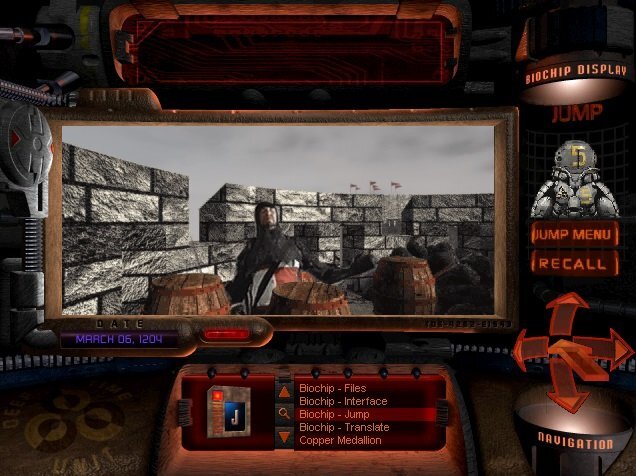
Picking Up The Arrow & Grappling Hook - 5/10 - First, I want to say that I find this setting highly compelling. Buried in Time is one of the few examples of a game using the post-Jeanne d'Arc part of the Hundred Years' War. It's a fun setting and as Buried in Time utilizes a real battle for this backdrop, it ends up playing like a stealth mission. Avoiding detection isn't that hard, and the game even provides an invisibility BioChip that allows you to avoid getting caught more easily. However, things start pretty blandly with you needing to pick up a bloody arrow from a dead soldier and a subsequent grappling hook that is required several times in the game. The tricky part is that the bloodied arrow is a pixelated mess and almost impossible to see unless you know what you are looking for, and the grappling hook is only marginally better. At least with the grappling hook, Arthur clues you into needing one when your character butts up against a wall. You do not use the arrow until you decide to complete the underground caves in the Mayan temple. Collecting both items is not in and of itself complicated, but it is a pain knowing what you need to gather in the first place.
Making A Key - 6/10 - For most players, making the copper key does not happen until you read a textbook in a knight's bedroom. After reading this book, you discover there is a hidden treasure room in Château Gaillard, and discern it is there you will be able to detect clues on who is behind the conspiracy against Gage. Having played this game before and wanting to speed things up, I decided to jump right into making the key since I already had all the necessary parts. When you turn to face the forge, you will notice two bricks running horizontally when the rest are vertical. Double-clicking one of the bricks reveals the mold to a key. To make the key, place the medallion from the Maya caves into a dish and click a nearby wooden bellow to stoke a fire. After the medal melts, click the pan to pour it into the mold and then collect the key that forms. Because Gage's suit is capable of withstanding hot molten metal, you do not need to chill the key in water after making it.
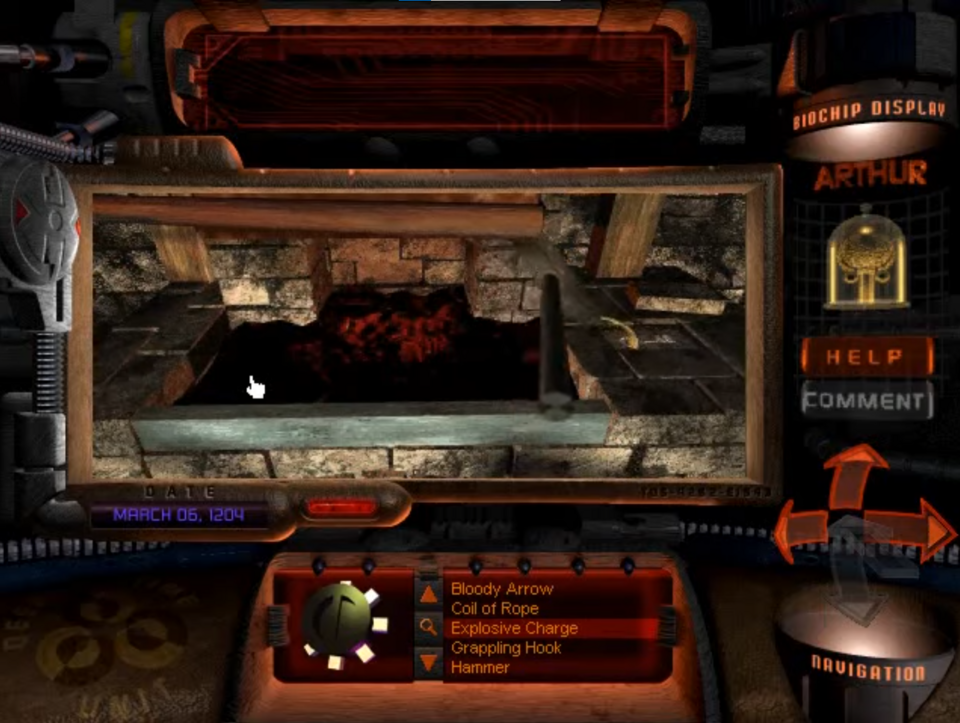
Boy, howdy did this puzzle give me Riven flashbacks! The task here is about clicking things in the correct order, but luckily the puzzle doesn't send you back a step if you click something wrong. Extinguishing the fire after melting the metal but before pouring it into the mold doesn't result in a "Game Over" as in other PC adventure games of this era. Also, there are not as many steps as you might think. So, you have a historically correct version of a "Gadget and Gizmo puzzle" wherein you keep clicking until you can progress the story. It might not be everyone's cup of tea, but it's not impossible to parse out on your own.
Finding The First Chateau Galliard Temporal Anachronism - 2/10 - Beyond the usual FMV-induced madness and adventuring gameplay, Buried in Time has one additional recurring hook. During the game's second act, you will need to collect evidence on who framed Gage for crimes against the time continuum. The first time this kicks into gear is at Château Gaillard, where, as you try to find the castle's hidden treasure, you will see signs of a different time traveler. The good news here is that Arthur blares that there's a temporal anachronism when you are near one and will even offer a hint if you have a hard time trying to find it. The only problem is that collecting evidence is a bit fiddly with you needing to select the "Evidence" BioChip and then click the clue's hitbox. The second part of that process is way more challenging than it should be, mind you. Still, this first clue, a random picture, is straightforward enough.
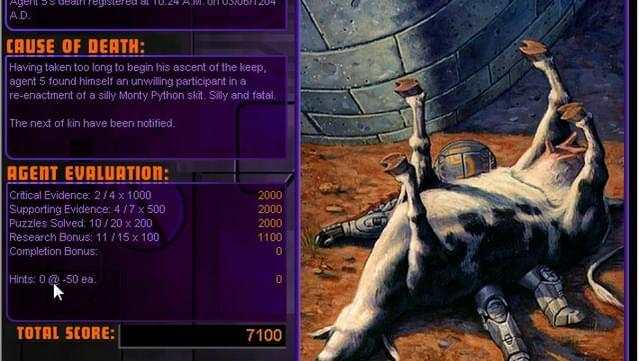
Using The Grappling Hook On The Castle - 2/10 - So, we know there's another time traveler and also that there's a hidden trove of treasure that might shed some light on who that might be. Before that, you'll also need to infiltrate the castle's keep using the grappling hook, and be quick about preventing the defending guards from dropping a cow on you. I did warn you that this game is goofy, right? The guards will unhook you mid-climb when you first attempt to scale the castle. The second climb will go without a hitch, but only if you are quick. When the guards that tried to thwart your scaling attempt earlier notice you entering a bedroom, you need to use the Invisibility BioChip. Both sequences require you to click things within a time constraint but are not nearly as oppressive as the space station.
Finding The Treasure Room At Château Gaillard - 4/10 - While in the keep, there are plenty of books and items to interact with, but not all are necessary for progressing the story. The gist is that you are at the castle during the late stages of the Siege of Château Gaillard, where the French attackers are moments away from taking the fortress. To find the treasure, you need to touch a tapestry near where you entered the room and then pick up a burnt letter from a fireplace. When you exit the first room, you will observe the other time traveler warping out of the castle, and your suit will automatically collect that as evidence. While in a cellar, you need to detect a nondescript chest and then use the key on the chest to unlock the entrance to a secret room below. While in the treasure room, you need to use the Evidence BioChip on a sword and pick up gold coins from a coffer.
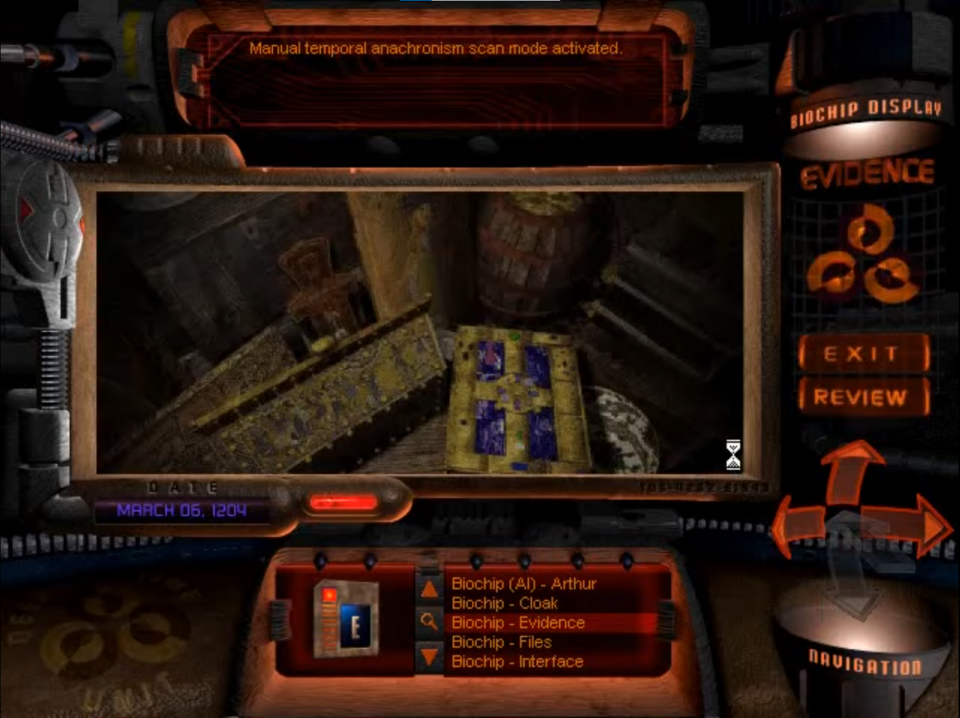
Again, the FMV veneer and time-traveling story elevate a standard turn-of-the-century puzzle format. The game provides a scenery-dense environment with a dozen screens and a handful of items you need to locate. Like Myst, you can process puzzles and environmental context clues at your preferred pace. With Arthur in tow, you can even get a history lecture from time to time. The only complication is that some rooms have guards, which will spell a "Game Over" if you are not careful. This design decision seems almost antithetical to what the game is trying to accomplish, but The Journeyman Project has always envisioned itself as more action-oriented than Myst. Therefore, you need to tangle with the fear of instant death occasionally.
Da Vinci's Studio
Finding The First And Second Temporal Anachronisms In Leonardo da Vinci's Studio - 2/10 - What is any time-traveling video game series without at least one leap into Leonardo da Vinci's workshop? There are a few things to note about this environment. First, you cannot complete this zone without the hammer from the smithy in Château Gaillard. Second, the villa has the fewest possible sources of death of any level in the game, short of Gage's apartment. There is one tricky "Game Over" you can get if you forget to summon the elevator and fall down its shaft, but that's the only one that jumps out to me. Otherwise, it is the breeziest level in the game and one of the few where you can appreciate the scenery and Arthur's lectures leisurely. There's also a key in a door that you use to get into this first room that you need to remember to pick up, or else you'll butt up against a locked door leading to the final level of this environment. Trust me; it is a bummer to forget that key.
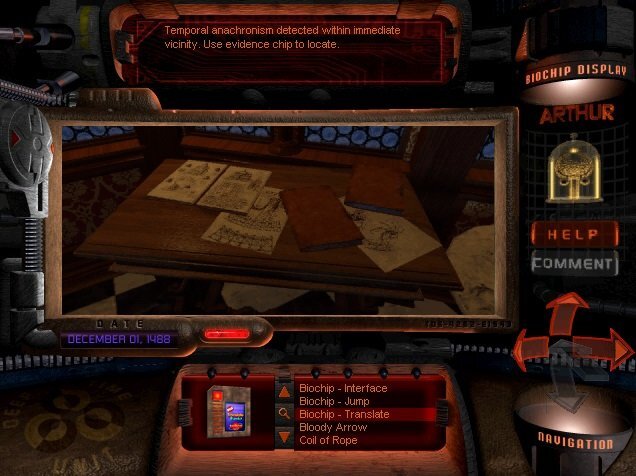
When collecting evidence, da Vinci's studio has a decent amount. In fact, you need to find your first clue almost immediately after warping into the level. The issue is that most of the evidence is on the floor of the studio or nearby villa, and the brown and beige tilework makes it impossible to distinguish where clues might exist. In this case, you need to take note of some red paint on the floor, but it is a dull enough red that almost matches the floor's texture. The good news is that the second clue is contained within a required unskippable cutscene that doesn't need you to fumble around with your BioChips to collect. There's a bit of aimless wandering here, but it is not the end of the world, and if you have Arthur, the game even warns you if you are getting colder or hotter to the clues.
Using The Elevator At Da Vinci's Studio - 2/10 - As I mentioned, there's an elevator at the studio, and you need to use it once to get to the ground floor of a surrounding villa. If you attempt to hop into the elevator without operating its crank, you will fall to your death. Instead, you use the "Translate" BioChip to translate Latin on two levers to discover which one is "Up" and which one is "Down." You use the up lever to raise the elevator to where you are currently standing, and after walking into it, you use the down lever to continue your adventure. I wouldn't typically rank something like this more than a one, but because this device is one of the only ways you can kill yourself here, and that "Game Over" isn't too off the beaten path, I'll bump it up to a two.

Building The Siege Machine - 6/10 - After lowering yourself to the ground floor, you need to move to a nearby room where you must pick up a rope and then move to a second room where you locate a drive assembly. Next to the drive assembly, you can observe the blueprint of an unfinished vehicle by da Vinci that can summit walls and towers. The blueprint indicates that there are other parts to this contraption that still need to be collected before you can hope to assemble it. These necessary components include two wooden pegs and a wheel assembly. The parts can only be put together on a specific workbench in the workshop, and the wooden pegs require a hammer from the French castle forge if you wish to connect them correctly. After placing all of the pieces in the correct spot and hammering the wooden pegs into place, you have a working "siege cycle" that you can use to reach the tower that you saw the other time traveler occupying.
This process is not a great experience. The issue is that the distance between some parts and the rooms containing them is vast. After picking up the drive assembly, the wooden pegs are nine steps or clicks away (i.e., Right-Forward-Left-Forward-Right-Forward-Forward-Forward-Forward-Down). Furthermore, the parts the game needs you to find are not easy to see in the first place because they are sometimes indistinguishable from the game's background and foreground textures. To highlight, I walked past the rope four or five times before I realized I was missing a part of the siege vehicle. It sure does not help that the workbench where you need to put all these pieces together is tucked away in a far corner of the workshop and easy to miss. Finally, while I appreciate the many interactable parts in the studio and workshop, very few have anything to do with moving the story forward. I spent five to seven minutes trying to pick up some of the game's window dressing, thinking they had to be quest items because Arthur lectured about them for three minutes. As a result, it's incredibly easy to get stuck here, and the hint system isn't especially helpful because all it repeats is that you should look at the blueprint if you are confused.
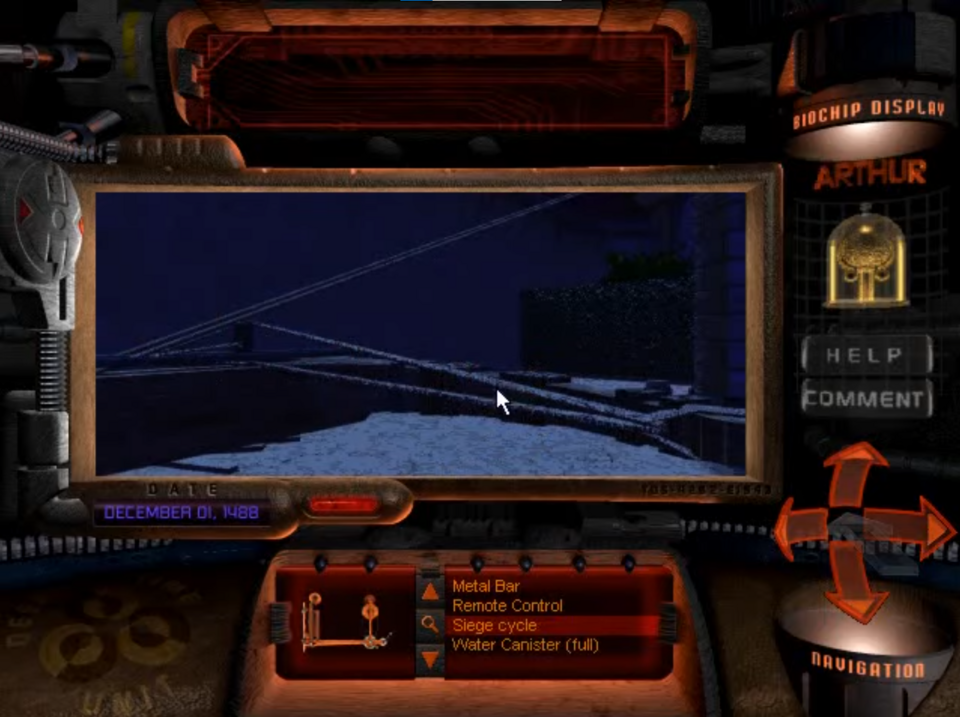
Using The Siege Cycle - 6/10 - Using the siege cycle is marginally more manageable than putting it together. First, you must find a ballista past a rose garden outside the workshop. This task might not sound like much, but it is not difficult to get lost here. From the workbench, you need to click Up-Left-Forward-Right-Forward-Left-Forward and then click to open a door. From there, you click Forward-Right-Forward-Left-Forward-Right-Right-Forward-Forward-Left-Forward-Left-Forward-Right-Right-Down. Fans of Buried in Time will likely contend that the villa is a circular loop. Even if you get lost, you will eventually find the ballista, but I value my time and thought the level design of this part was a significant annoyance. When you find the ballista, you need to click its base once to turn it to face the correct castle. I did the rest of this puzzle first without doing this and did not know why the machine was not working.
When you enter the operator's position of the machine, you use two handles to adjust the ballista's pitch and yaw axis. If you read a note by da Vinci, you would know that you need to align the crosshairs with a star constellation, but for most, you click the left-handle right nine times and the right knob down twice. With the crosshair in the correct position, the ballista hooks a rope to a building, and you can place the siege cycle on the cord and then ride it to the final level of this environment. As you might expect, this puzzle is either something you look up the answer to or fiddle around with for hours. The feedback the game provides is far from great, but at least the target you are aiming for is clear enough. The note I mentioned earlier that provides your only clue is vague about which stars to use as your guide, and it's not entirely helpful. However, because this puzzle doesn't have a timer breathing down your neck and the ammunition to the ballista is endless, I can't judge it too harshly.
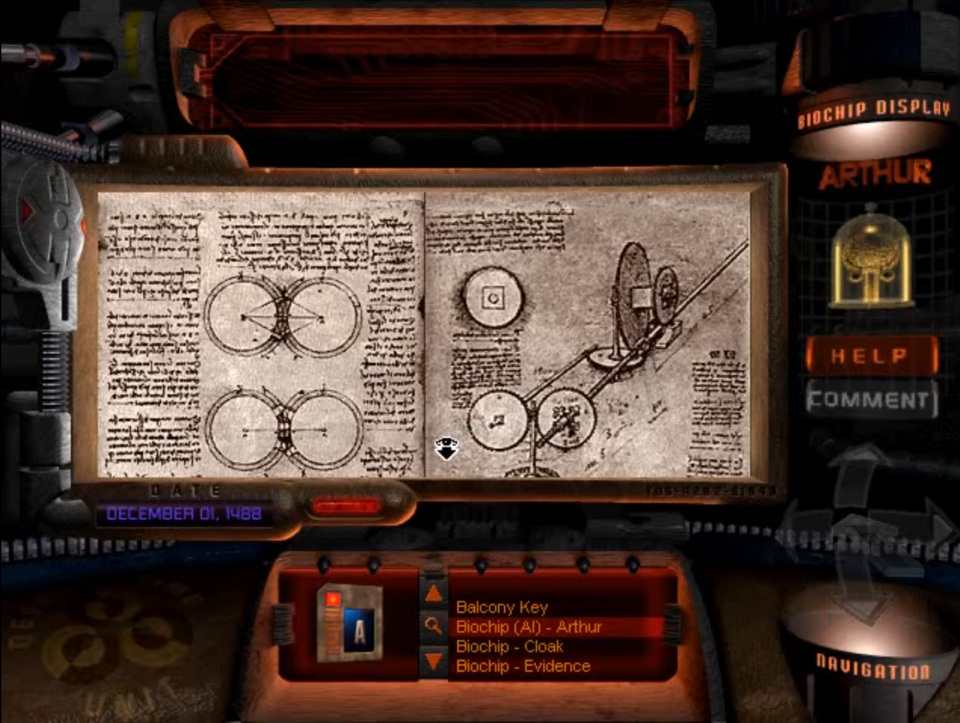
Finding A Lens And Attaching It To Your Time Suit - 4/10 - First, remember the key I said you need to pick up on the first level? It sure would be a bummer if you did everything necessary to get to the last part of this environment, only to be unable to because you forgot that key. That sure would be a not fun experience! After you unlock the door, you will watch as the other time traveler departs and immediately need to observe a lens that fell from their suit. However, you will need to collect that lens and attach it to Gage's. This process is oddly fiddly but far from impossible. You can use this lens to observe a book in the final tower of the villa and notice that the time traveler has edited some of its scripts. Fun fact, the game only requires you to observe the lens as evidence and does not require you to pick it up. You should not do that because the final level in the entire game becomes impossible if you leave it behind, and you can even get stuck in a weird late-game fail state. That alone bumps this score up ever so slightly.
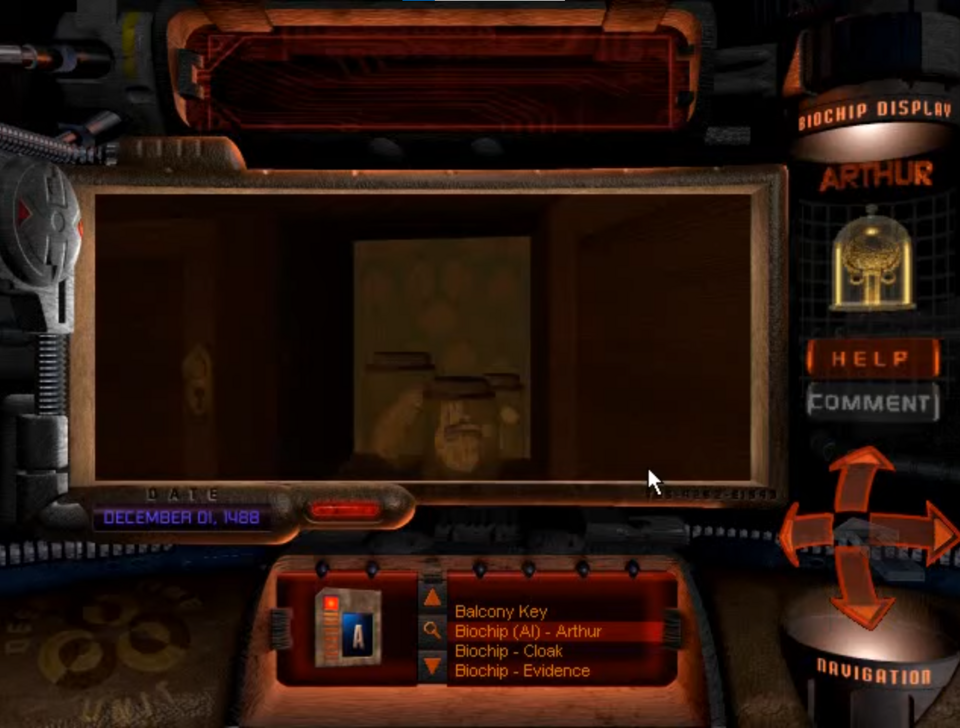
Remembering To Pick Up The Human Heart - 7/10 - Speaking of random bullshit that can fuck you over if you are not careful, let's talk about this human heart before we close this episode! Buried in Time will lock you into specific screens or environments until you have located a required set of clues or cutscenes. Once you have collected all of the possible clues or sources of evidence at any given level, it will even tell you that there's nothing left for you to do. This warning is complete and total bullshit because the game does not count necessary story items. This design decision is a problem with da Vinci's villa because in the very last room exists a non-descript cupboard that has a human heart that you will eventually need for the final part of the Maya temple sequence. This cupboard doesn't look especially important, and when you open it, there's nothing to indicate that the heart is even something you can add to your inventory. And yet, it is, and if you forget to do this, you will need to drag your ass from wherever you are (usually the Mayan caves) to the start of the villa to make the long trek to the final tower, ballista, and all, a second time. That is what I call a "dick move."
